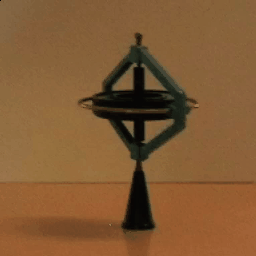Gyroscopes: Difference between revisions
Ansley Marks (talk | contribs) No edit summary |
Ansley Marks (talk | contribs) No edit summary |
||
| Line 14: | Line 14: | ||
When the spinning axis of a gyroscope is placed on a support, a gyroscopic effect is observed. The gyroscope bobs up and down--nutation--and rotates about the support--precession. For the sake of simplifying the mathematical equations for a gyroscope's motion, nutation (the upwards and downwards movement of the rotor) will be ignored. We will only look at the precession motion of the gyroscope. | When the spinning axis of a gyroscope is placed on a support, a gyroscopic effect is observed. The gyroscope bobs up and down--nutation--and rotates about the support--precession. For the sake of simplifying the mathematical equations for a gyroscope's motion, nutation (the upwards and downwards movement of the rotor) will be ignored. We will only look at the precession motion of the gyroscope. | ||
[[File: | [[File: gyroprecess.png]] | ||
To start off with, | To start off with, | ||
Revision as of 20:37, 1 December 2015
An explanation by Ansley Marks
A gyroscope is a device containing a wheel or disk that is free to rotate about its own axis independent of a change in direction of the axis itself. Since the spinning wheel persists in maintaining its plane of rotation, a gyroscopic effect can be observed.
The Main Idea
Although insignificant looking and seemingly uninteresting when still, gyroscopes become a fascinating device when in motion and can be explained using the angular momentum principle. Gyroscopes come in all different forms with varying parts. The main component of a gyroscope is a spinning wheel or a disk mounted on an axle. Typically gyroscopes contain a suspended rotor inside three rings called gimbals. In order to ensure that little torque is applied to the inside rotor, the gimbals are mounted on high quality bearing surfaces, allowing free movement of the spinning wheel in the middle. These types of gyroscopes with multiple gimbals are useful for stabilization because the wheels can change direction without affecting the inner rotor. If the spinning axle of a gyroscope is placed on a support, then a complex motion can be observed. The motion of a gyroscope will be modeled and explained further on in this page.
A Mathematical Model
When the spinning axis of a gyroscope is placed on a support, a gyroscopic effect is observed. The gyroscope bobs up and down--nutation--and rotates about the support--precession. For the sake of simplifying the mathematical equations for a gyroscope's motion, nutation (the upwards and downwards movement of the rotor) will be ignored. We will only look at the precession motion of the gyroscope.
To start off with,
A Computational Model
How do we visualize or predict using this topic. Consider embedding some vpython code here Teach hands-on with GlowScript
Examples
Be sure to show all steps in your solution and include diagrams whenever possible
Simple
Middling
Difficult
Connectedness
- How is this topic connected to something that you are interested in?
- How is it connected to your major?
- Is there an interesting industrial application?
History
Put this idea in historical context. Give the reader the Who, What, When, Where, and Why.
See also
Are there related topics or categories in this wiki resource for the curious reader to explore? How does this topic fit into that context?
Further reading
Books, Articles or other print media on this topic
External links
Internet resources on this topic
References
Oxford Dictionaries: http://www.oxforddictionaries.com/us/definition/american_english/gyroscope
HyperPhysics: http://hyperphysics.phy-astr.gsu.edu/hbase/gyr.html
Wikipedia: https://en.wikipedia.org/wiki/Gyroscope

